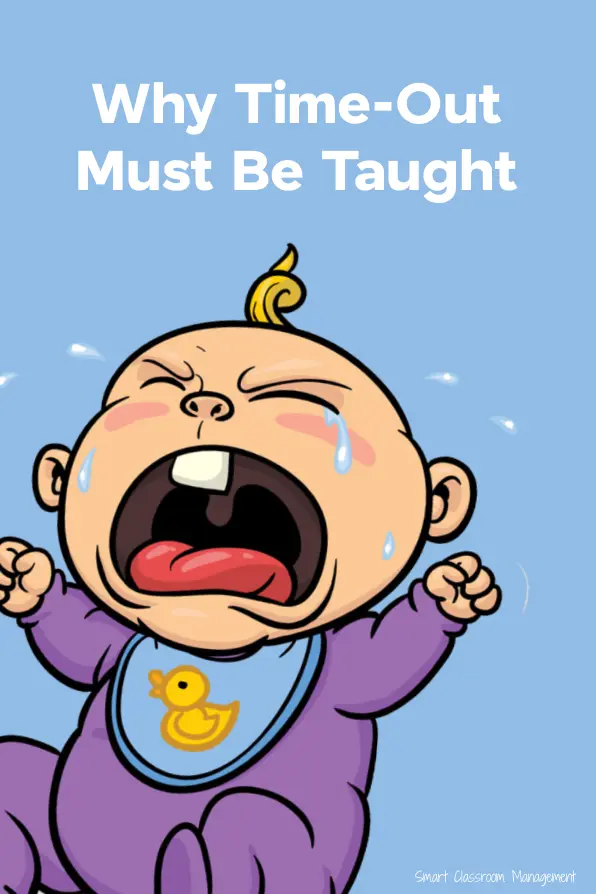You don’t have to call it time-out. You can call it the reflection zone, the accountability desk, or anything you like. The name is unimportant.
But what is important, critically, is that it must be taught.
It must be explained in detail, modeled explicitly, and practiced until your students know every step of the time-out process.
This includes . . .
1. The meaning of time-out.
2. What you will say to send them to time-out.
3. How they must go to time-out and what to take with them.
4. What they’re allowed and not allowed to do in time-out.
5. How to reflect on their misbehavior.
6. The conditions they must meet to leave time-out.
7. What you will say to invite them back to the class.
There are three reasons why you must be so thorough.
1. Because it limits disruption.
Done right, sending a student to time-out should be seamless and virtually unnoticeable to the rest of the class. A quick word or signal from you and then you’re immediately back to teaching.
This keeps the focus on academics, where it needs to remain from opening bell to dismissal—which in turn helps further tamp down misbehavior.
And because the whole class understands the ins and outs of time-out, and what exactly constitutes breaking rules, they have no reason to interrupt and comment or give their two cents regarding the misbehavior.
2. Because it eliminates debate.
Here at SCM, we believe in transparently laying all of our cards out on the table and making sure students know every aspect of our classroom management plan. There should be no secrets, no additional lectures or talking-tos, and no gray areas.
When students know where the line is that when crossed triggers a consequence, and they’re held accountable 100 percent of the time, then there is no reason to argue. You have them dead to rights and they know it. Thus, arguing is fruitless.
You refuse to battle anyway and simply let your plan and its detailed parameters do the dirty work for you. The result is that students go to time-out without delay or resistance.
3. Because it ensures effectiveness.
When your students know, and prove to you they know, your rules beyond any doubt, then they also know the instant they’ve transgressed them. They feel it like a freedom-loving dog with a shock collar easing over an underground fence.
They expect your promised response, which comes as predictable as light after a flipped switch.
And when students know, when they have the A to Z handbook of classroom dos, don’ts, and whys, embedded in their DNA, then they naturally reflect on their misbehavior. They accept responsibility and resolve not to make the same mistake again.
Peace & Respect
If you teach time-out in detail, leaving nothing to chance and no stone unturned, and combine it with consistent follow through, then time-out will work as it should.
It will dissuade further misbehavior.
However, most teachers don’t teach it to the reaches of thoroughness it requires. And yet they wonder why they have students refusing time-out, crying in time-out, and complaining to their parents that their mean teacher is picking on them.
You must teach time-out in excruciating detail. You must test your students’ understanding and make them prove they “got it” before putting it into practice. Beginning of the year is best, of course. The next best time, however, is right now.
So go and do it. The right way. And bring peace and respect to your classroom.
PS – For more on time-out, please check out The Smart Classroom Management Plan for Elementary Teachers.
Also, if you haven’t done so already, please join us. It’s free! Click here and begin receiving classroom management articles like this one in your email box every week.

Michael is right. His methods have let me keep a Dream Classroom even in rooms that were promised to be “impossible” – and to keep a warm, honestly friendly rapport even with students who never had a teacher that didn’t dread them. The biggest thank you.
Love this! Setting kids (and yourself) up for success
Hi, Michael!
I have been teaching since 1982. With all my experience, I can absolutely say: every thought of yours, every strategy, every approach completely resonates with me as a teacher. Your ideas are uplifting, reassuring, very professional and simply smart. I have been following you for years. I’m always happy to read a new entry.
Thank you!
Nadia
Thank you, Nadia!
Yep. Going to teach this again this week with new classes for 2nd semester. I will definitely do it in a more intentional and thorough way. Thanks.
Hi Michael,
I became familiar with you and your work through the Rise Up Summit and I find I can’t stop reading your blogs. I am a principal at a middle school and we have time out in the classroom. Have you had a student refuse to move to time out? What did you do in that situation? Thank you again for sharing your work and expertise!
Hi Abby,
Here is an article on the topic: https://smartclassroommanagement.com/2012/03/31/what-to-do-when-a-student-refuses-to-go-to-time-out/